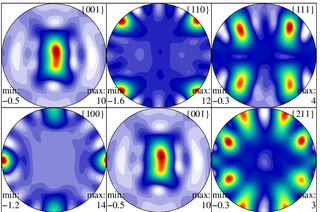Top Qs
Timeline
Chat
Perspective
Titanium aluminide
Intermetallic chemical compound From Wikipedia, the free encyclopedia
Remove ads
Titanium aluminide (chemical formula AlTi), commonly gamma titanium, is an intermetallic chemical compound. It is lightweight and resistant to oxidation[1] and heat, but has low ductility. The density of γ-TiAl is about 4.0 g/cm3 (0.14 lb/cu in). It finds use in several applications including aircraft, jet engines, sporting equipment, and automobiles.[citation needed] The development of TiAl based alloys began circa 1970. The alloys have been used in these applications only since about 2000.
Titanium aluminide has three major intermetallic compounds: gamma titanium aluminide (gamma TiAl, γ-TiAl), alpha 2-Ti3Al and TiAl3. Among the three, gamma TiAl has received the most interest and applications.
Remove ads
Applications of gamma-TiAl
Summarize
Perspective

Gamma TiAl has excellent mechanical properties and oxidation and corrosion resistance at elevated temperatures (over 600 °C (1,112 °F; 873 K)), which makes it a possible replacement for traditional Ni based superalloy components in aircraft turbine engines.
TiAl-based alloys have potential to increase the thrust-to-weight ratio in aircraft engines. This is especially the case with the engine's low-pressure turbine blades and the high-pressure compressor blades. These are traditionally made of Ni-based superalloy, which is nearly twice as dense as TiAl-based alloys. Some gamma titanium aluminide alloys retain strength and oxidation resistance to 1,000 °C (1,830 °F; 1,270 K), which is 400 °C (752 °F; 673 K) higher than the operating temperature limit of conventional titanium alloys.[not specific enough to verify][3]
General Electric uses gamma TiAl for the low-pressure turbine blades on its GEnx engine, which powers the Boeing 787 and Boeing 747-8 aircraft. This was the first large-scale use of this material on a commercial jet engine[4] when it entered service in 2011.[5] The TiAl LPT blades are cast by Precision Castparts Corp. and Avio s.p.a. Machining of the Stage 6, and Stage 7 LPT blades is performed by Moeller Manufacturing.[6][citation needed] An alternate pathway for production of the gamma TiAl blades for the GEnx and GE9x engines using additive manufacturing is being explored.[7]
Remove ads
Alpha 2-Ti3Al
Alpha 2-Ti3Al is an intermetallic compound of titanium and aluminum, belonging to the Ti-Al system of advanced high-temperature materials. It is primarily used in aerospace and other high-performance applications due to its balance of strength, lightweight properties, and oxidation resistance.
It has an ordered hexagonal (D019) crystal structure, which makes it distinct from the more commonly known γ-TiAl (gamma titanium aluminide).
Remove ads
TiAl3
TiAl3 has the lowest density of 3.4 g/cm3 (0.12 lb/cu in), the highest micro hardness of 465–670 kg/mm2 (661,000–953,000 lbf/in2) and the best oxidation resistance[compared to?] even at 1,000 °C (1,830 °F; 1,270 K). However, the applications of TiAl3 in the engineering and aerospace fields are limited by its poor ductility. In addition, the loss of ductility at ambient temperature is usually accompanied by a change of fracture mode from ductile transgranular to brittle intergranular or to brittle cleavage. Despite the fact that a lot of toughening strategies have been developed to improve their toughness[incomprehensible], machining quality is still a difficult problem to tackle. Near-net shape manufacturing technology is considered as one of the best choices for preparing such materials.[citation needed]
References
External links
Wikiwand - on
Seamless Wikipedia browsing. On steroids.
Remove ads